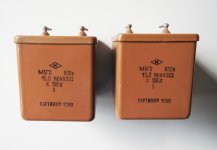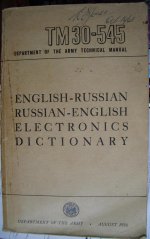The middle part is all clear, I mean the first line <K> and as a curiosity also the bottom line. Does <K> signify maybe another quality or usage than the regular <OTK> stamp.
I understand from these markings that these caps are MBGO 10µF 600V made in 1969. I'm just curious about any additional info from the rest of the markings. In my experience this forum contains expertise in all things russian electronics. =)
the 600B is voltage as you have stated.
But is that DC, or AC?
How would the other be marked?
How would polar be marked?
Which part tells the material/dielectric?
What is
But is that DC, or AC?
How would the other be marked?
How would polar be marked?
Which part tells the material/dielectric?
What is
and is that a translation of the first 4 letters of the second line?MBGO
MBGO is the type, it's non polar metallized oiled paper hermetically sealed.
I don't know about the DC or AC ratings, that's a good question. Does anybody know?
In practise, it doesn't matter. These caps usually withstand much higher voltages than marked for, in my experience. In circuits I use them within ratings, but I've done some experiments.
I've run 200V KBG type paper in oil caps as parafeed caps for years with transients up to 400 volts. They also keep a 300 to 400 V DC voltage at least short term - I wouldn't put them in a circuit like that of course.
I don't know about the DC or AC ratings, that's a good question. Does anybody know?
In practise, it doesn't matter. These caps usually withstand much higher voltages than marked for, in my experience. In circuits I use them within ratings, but I've done some experiments.
I've run 200V KBG type paper in oil caps as parafeed caps for years with transients up to 400 volts. They also keep a 300 to 400 V DC voltage at least short term - I wouldn't put them in a circuit like that of course.
oiled paper sounds like paper in oil (PIO)MBGO is the type, it's non polar metallized oiled paper hermetically sealed.
Since this is metalised, rather than foil, it becomes MK, so the full type code would be MKPIO.
Does that make sense?
And a foil between paper in oil would be MFPIO?
I have some that are marked to the equivalent of MBGO, but with a -1 immediately after.
Does the -1 mean something?
I also spotted that what I thought was OK is actually OTK closed right up into a logo.
OTK = military. Does that have something to do with temperature range?
Does the -1 mean something?
I also spotted that what I thought was OK is actually OTK closed right up into a logo.
OTK = military. Does that have something to do with temperature range?
The K Logo is the brand name of Мезон (MEZON), of the erstwhile Leningrad (St Petersburg).
They are still in St Petersburg:
JSC MESON FACTORY
They are still in St Petersburg:
JSC MESON FACTORY
When do the Russian language classes start?
Do we need to register in advance?
No registration. But you must obtain the course text:
.
Attachments
Hello,
I have some K50-35 capacitors. How to know where is pos/neg polarity ?
Ê50-35 - êîíäåíñàòîðû ýëåêòðîëèòè÷åñêèå àëþìèíèåâûå - õàðêòåðèñòèêè êóïèòü this link shows long leg getting positive pole.
The photo shows " + " in side of short leg.
what is correct ?
Best regards,
Tran.
I have some K50-35 capacitors. How to know where is pos/neg polarity ?
Ê50-35 - êîíäåíñàòîðû ýëåêòðîëèòè÷åñêèå àëþìèíèåâûå - õàðêòåðèñòèêè êóïèòü this link shows long leg getting positive pole.
The photo shows " + " in side of short leg.
what is correct ?
Best regards,
Tran.
Attachments
MBGO
Warranty period of storage 10 years from datasheet
http://www.eandc.ru/pdf/kondensator/mbgo.pdf
Warranty period of storage 10 years from datasheet
http://www.eandc.ru/pdf/kondensator/mbgo.pdf
- Home
- Design & Build
- Parts
- Russian capacitor markings


